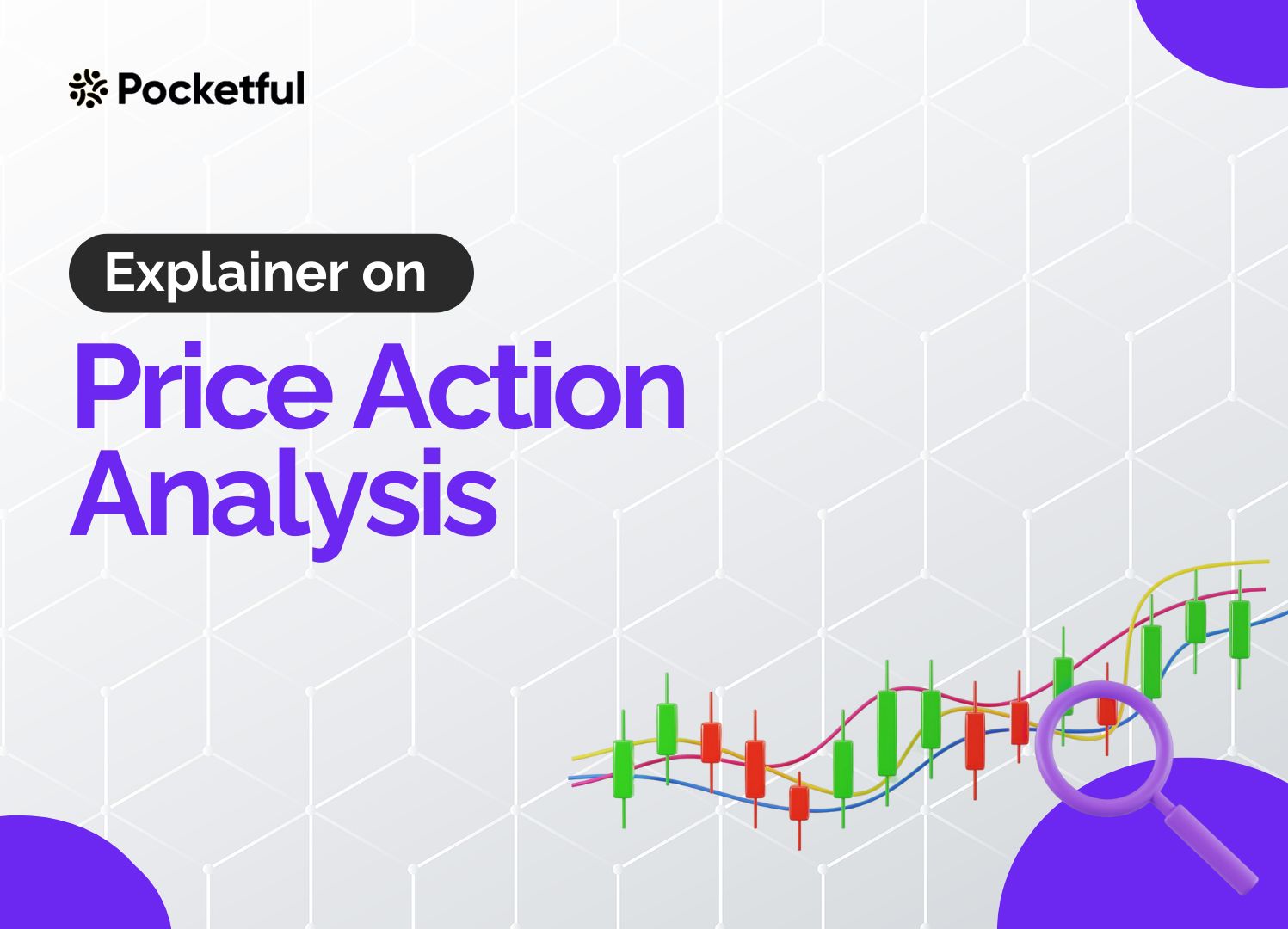| Type | Description | Contributor | Date |
|---|---|---|---|
| Post created | Pocketful Team | Apr-26-24 | |
| FAQs Formatting | Nisha | Mar-04-25 |

- Blog
- price action analysis
Price Action Analysis: An Easy Explainer


Have you ever felt the stock market is a complex puzzle with cryptic messages hidden within its charts? Price action analysis can be your decoder ring. This trading technique sheds light on the market psychology by focusing on the price movements.
In this blog, we will delve deeper into the world of price action analysis, exploring its core principles and how you can use them to make informed trading decisions.
Price Action Overview
Price Action Analysis is a method for traders to understand the market by examining the movement of a security’s price over time. It is a core concept in technical analysis, though some consider it distinct because it completely focuses on price movements without relying on additional indicators.
Price action traders concentrate on the highs, lows, openings and closings of a security’s price to identify trends, buying and selling pressures and trading opportunities.
By analysing price movements, traders can determine whether the price is in an uptrend, downtrend, or consolidation phase.
Traders use price action analysis to make informed decisions about entering or exiting trades.
Evolution of Price Action Analysis

Although the exact origin of price action analysis is unclear, but we can trace its roots back to the beginning of the market analysis.
In the early 20th century, before formal technical analysis existed, traders tracked prices on charts. This focus on price movements itself is the foundation of price action analysis.
In the 1880s, Charles Dow, a journalist and financial analyst, laid the groundwork for technical analysis with his Dow Theory. While not purely price-action-focused, it emphasized the importance of trends and price movements.
In the 1900s, technical indicators like moving averages and RSI started gaining prominence. While these provided additional data points, price remained a key input.
The late 20th century made traders feel that the dependence on complex indicators was detracted from understanding the price. This led to a renewed focus on price action analysis as a distinct approach.
Since then, the rise of online trading platforms and advanced charting software has made price action analysis more accessible to individual traders.
How to use Price Action Analysis
- Remove clutter from your charts. Get rid of technical indicators such as RSI, MACD, Bollinger Bands, etc. leaving just candlesticks to focus purely on price movements.
- Understand the concept of uptrends and downtrends to understand the overall direction.
- Numerous price patterns emerge from the price action and can signal future movements. Some of the common examples are,
- Reversal Patterns – Head & Shoulders, Double top/bottom, Triple top/bottom, etc.
- Continuation Patterns – Pennants, Flags, Triangles, etc.
- Breakout Patterns – Breakouts above resistance or below support can signal trend continuation.
While price action is valuable, it should not be used in isolation. Consider using it alongside other confirmation methods such as volume, corporate events, news & events, etc.
Once you have grasped these concepts, you can use price action analysis to develop a trading strategy. This entails determining entry and exit points for your trades based on identified patterns and confirmations. Remember that every trader has their own judgement and analysis.
Advantages of Price Action Analysis
There are several advantages of using price action in your trading strategy. A few of them are:
- Price action focuses on the core element of the market, i.e., price itself. This can be easier to learn and understand.
- It can be applied to almost all the markets and asset classes, regardless of the underlying security or economic factors. In forex trading, most of the traders use Price Action analysis as there are no fundamentals in the forex market.
- Price Action highlights trends which allow traders to position themselves according to the prevailing trend.
- Understanding support, resistance levels, and critical concepts in price action analysis can help traders set stop-loss orders to manage risk.
- Unlike some technical indicators that may become outdated as markets evolve, price action analysis focuses on the fundamental concept of price movements, making it a timeless approach.
Disadvantages of Price Action Analysis
- Interpreting pricing trends is subjective, which is a disadvantage. It is highly likely that traders can evaluate the same price activity and come to different conclusions, which can lead to missed opportunities or even bad trades if misinterpretations occur.
- Price patterns are not perfect predictors; they may generate false signals, which can lead to wrong trades. This can be frustrating and result in losses.
- Price movements can be influenced by short-term factors and random noise, making it challenging to distinguish between genuine signals and fleeting fluctuations. This can lead to confusion and difficulty in making clear trading decisions, particularly in short time frames.
- Price action analysis focuses solely on price movements and ignores other important factors that can affect markets, such as fundamental company analysis, economic data and news events. These factors can also affect prices and should be considered for a well-rounded analysis.
- Past price movements do not necessarily dictate future outcomes. Markets can be unpredictable, and unexpected events can cause price movements to deviate from expected patterns.
Read Also: What is Price Action Trading & Price Action Strategy?
Conclusion
Price action analysis offers a valuable lens for understanding the market. However, it is just one piece of the trading puzzle. You can strengthen your trading decisions by combining it with other technical analysis methods, such as RSI, MACD, Moving Averages, etc., and sound risk management strategies.
Moreover, to accurately spot patterns using price action analysis, it needs time and effort. New traders may require assistance interpreting the charts correctly.
As you gain experience, you will develop your own analytical edge and become more confident in navigating the ever-changing market landscape.
If you’re facing difficulty in Risk Management, check out our blog – Risk Management in Trading
Frequently Asked Questions (FAQs)
What is a Price Action analysis?
In Price Action analysis, you look at price movements on charts to identify trends, support/resistance levels, and trading opportunities.
What do price action traders focus on?
The price action traders focus on Candlestick patterns and analyse how price interacts with past highs and lows.
Is price action challenging to learn?
The core concepts are relatively simple, but mastering it takes time and practice.
Do I need special software for price action analysis?
There is no requirement of a special charting software. Any charting platform that shows historical price data will work for Price Action analysis.
Is price action analysis good for day trading or long-term investing?
It can be applied to both, depending on the specific patterns and timeframes used. However, the shorter the time frame, the higher the chances of generating noise, which may create issues in identifying trends.
Disclaimer
The securities, funds, and strategies discussed in this blog are provided for informational purposes only. They do not represent endorsements or recommendations. Investors should conduct their own research and seek professional advice before making any investment decisions.